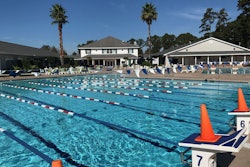SOURCE: National Federation of State High School Associations (NFHS)
INDIANAPOLIS, IN (August 26, 2019) — Participation in high school sports declined in 2018-19 for the first time in 30 years, according to the annual High School Athletics Participation Survey conducted by the National Federation of State High School Associations (NFHS).
The 2018-19 total of 7,937,491 participants is a decline of 43,395 from the 2017-18 school year when the number of participants in high school sports reached an all-time record high of 7,980,886. This year’s total – the third-highest ever – consisted of 4,534,758 boys and 3,402,733 girls, according to the figures obtained from the 51-member state high school associations, which includes the District of Columbia. The last decline in sports participation numbers occurred during the 1988-89 school year.
“We know from recent surveys that the number of kids involved in youth sports has been declining, and a decline in the number of public school students has been predicted for a number of years, so we knew our ‘streak’ might end someday,” said Dr. Karissa Niehoff, NFHS executive director. “The data from this year’s survey serves as a reminder that we have to work even harder in the coming years to involve more students in these vital programs – not only athletics but performing arts programs as well.”
The biggest contributors to the decline were the two longstanding and popular sports of football and basketball. Participation in boys 11-player football declined by 30,829 participants to 1,006,013 – the lowest mark since 1,002,734 in the 1999-2000 school year.
Although the actual number of participants in boys 11-player football dropped for the fifth consecutive year, the number of schools offering the sport remained steady. The survey indicated that 14,247 schools offer 11-player football – an increase of 168 from last year. A comparison of the figures from the past two years indicates that the average number of boys involved in 11-player football on a per-school basis dropped from 73 to 70, which would include freshman, junior varsity and varsity teams.
While participation in boys 11-player football dropped in all but seven states, participation in 6-player, 8-player and 9-player gained 156 schools and 1,594 participants nationwide, with the largest increase in boys 8-player football from 19,554 to 20,954. In addition, in the past 10 years, participation by girls in 11-player football has doubled – from 1,249 in the 2009-10 school year to 2,404 last year.
“The survey certainly confirms that schools are not dropping the sport of football, which is great news,” Niehoff said. “Certainly, we are concerned about the reduction in the number of boys involved in the 11-player game but are thrilled that states are finding other options by starting 6-player or 8-player football in situations where the numbers have declined.
“While we recognize that the decline in football participation is due, in part, to concerns about the risk of injury, we continue to work with our member state associations, the nation’s high schools and other groups to make the sport as safe as possible. Every state has enacted rules that limit the amount of contact before the season and during practices, and every state has concussion protocols and laws in place, so we continue to believe that the sport is as safe as it has ever been.
“We also are working with groups such as USA Football to reduce contact and teach proper tackling skills at the youth levels to increase the interest level as kids reach junior high school and high school.”
Combined basketball participation was down 23,944 (13,340 girls and 10,604 boys), and the girls basketball total of 399,067 is the lowest since the 1992-93 school year. However, the decrease in girls basketball participation from 430,368 in 2016-17 to 399,067 in 2018-19 is largely attributable to a 25,000 drop in Texas during that two-year period. Dismissing the Texas numbers, girls basketball numbers have been steady in the range of 430,000 for the past seven years.
Four of the top 10 boys sports registered increases in participation, topped by track and field with an additional 5,257 participants. Other top 10 boys sports that added participants last year were soccer (2,715), wrestling (1,877) and tennis (1,163). Among girls top 10 sports, volleyball was the front-runner with an additional 6,225 participants, followed by soccer (3,623) and lacrosse (3,164).
In addition to an increase in girls volleyball and boys wrestling, the sports continued to gain interest across genders. Boys participation in volleyball registered a four percent increase and now has 63,563 participants nationwide, and girls wrestling jumped 27 percent and now has 21,735 participants.
The most significant increases from last year were registered in the adapted and Unified sports programs. The various adapted sports sponsored by schools across the country gained 4,102 participants, while Unified sports participation increased 2,938.
With 1,006,013 participants, 11-player football remains the No. 1 participatory sport for boys in high school by a large margin. Outdoor track and field is No. 2 with 605,354 participants, followed by basketball (540,769), baseball (482,740), soccer (459,077), cross country (269,295), wrestling (247,441), tennis (159,314), golf (143,200) and swimming/diving (136,638).
Outdoor track and field continues to lead the way for girls with 488,267 participants, followed by volleyball (452,808), basketball (399,067), soccer (394,105), fast-pitch softball (362,038), cross country (219,345), tennis (189,436), swimming/diving (173,088), competitive spirit (161,358) and lacrosse (99,750).
While some of the traditional sports such as football, basketball and baseball have remained steady and/or experienced slight declines in the past seven years, other sports have registered significant gains since 2012. Participation in girls lacrosse and boys lacrosse has increased 19 percent during that time with a combined 213,452 participants in 2018-19. Girls and boys soccer gained 70,668 participants since 2012 (a nine percent increase) and now has a combined 853,182 participants nationwide.
Interest in boys volleyball (26 percent gain) and girls volleyball (eight percent gain) has continued to climb the past seven years with totals of 63,563 and 452,808, respectively, in 2018-19. Among girls sports, competitive spirit has increased 38 percent since 2012 with 161,358 participants.
“While we will do everything in our power to regain participation levels in football and other traditional sports, we are thrilled with reports from sports such as volleyball, lacrosse, soccer, competitive spirit and some of the emerging sports,” Niehoff said. “Our ultimate goal is to involve as many students as possible in high school sports and other activity programs.”
This year’s survey indicated participation by high school students in 70 different sports, as well as 14 adapted sports for students with disabilities. Some of the more popular non-traditional sports were bowling (61,291), weightlifting (29,144), badminton (18,162), flag football (12,154) and archery (10,391).
The top 10 states by participants remained the same in 2018-19. Texas and California topped the list again with 825,924 and 824,709 participants, respectively, followed by New York (369,266), Ohio (339,158), Illinois (333,838), Pennsylvania (316,429), Florida (308,173), Michigan (292,947), New Jersey (281,058) and Minnesota (240,487). Only Texas, California and Minnesota reported higher figures than the previous year.
The participation survey has been compiled in its current form by the NFHS since 1971 through numbers it receives from its member state associations. The complete 2018-19 High School Athletics Participation Survey is available via the following link:
https://www.nfhs.org/sports-resource-content/high-school-participation-survey-archive/
About the National Federation of State High School Associations (NFHS)
The NFHS, based in Indianapolis, Indiana, is the national leadership organization for high school sports and performing arts activities. Since 1920, the NFHS has led the development of education-based interscholastic sports and performing arts activities that help students succeed in their lives. The NFHS sets direction for the future by building awareness and support, improving the participation experience, establishing consistent standards and rules for competition, and helping those who oversee high school sports and activities. The NFHS writes playing rules for 16 sports for boys and girls at the high school level. Through its 50 member state associations and the District of Columbia, the NFHS reaches more than 19,500 high schools and 12 million participants in high school activity programs, including almost 8 million in high school sports. As the recognized national authority on interscholastic activity programs, the NFHS conducts national meetings; sanctions interstate events; offers online publications and services for high school coaches and officials; sponsors professional organizations for high school coaches, officials, speech and debate coaches, and music adjudicators; serves as the national source for interscholastic coach training; and serves as a national information resource of interscholastic athletics and activities. For more information, visit the NFHS website at www.nfhs.org.





























